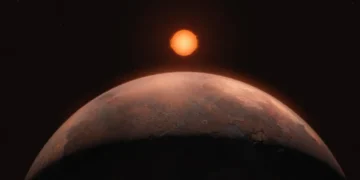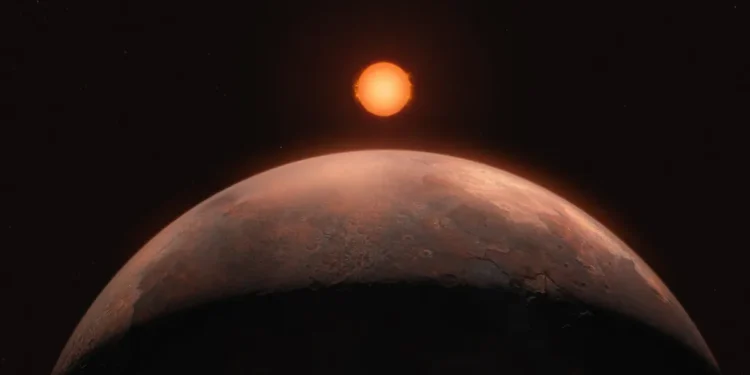In a groundbreaking astronomical discovery, scientists have confirmed the existence of four small, rocky exoplanets orbiting Barnard’s Star, one of our closest stellar neighbors. Located approximately six light-years away from Earth, Barnard’s Star has long been a subject of interest for astronomers seeking to understand planetary systems beyond our own.
Barnard’s Star: A Brief Overview
Barnard’s Star is a red dwarf, the smallest type of regular star, with about 16% of the Sun’s mass and far less heat. Its proximity to Earth and unique characteristics have made it a focal point for exoplanet research. Despite its dimness, the star’s closeness allows astronomers to study it in detail, providing a unique opportunity to explore planetary bodies in our cosmic backyard.
This red dwarf is particularly famous for having the fastest known “proper motion” of any star, meaning it appears to move the fastest across Earth’s night sky. Over thousands of years, its position noticeably shifts against the background of distant stars. Because of its relative nearness and high visibility, it has been a prime target for exoplanet searches.
The Discovery: Four Sub-Earth Mass Planets
The four newly discovered exoplanets are remarkable for their diminutive sizes, each possessing a mass ranging from 19% to 34% that of Earth. This positions them among the smallest exoplanets ever detected, highlighting the precision of current astronomical instruments.
- Planet d: With a mass approximately 26% that of Earth, it completes an orbit around Barnard’s Star every 2.34 days at a distance of 1.7 million miles (2.8 million kilometers).
- Planet b: This planet has a mass 30% that of Earth and orbits its star every 3.15 days at a distance of 2.13 million miles (3.4 million kilometers).
- Planet c: The largest of the quartet, it possesses a mass 33.5% that of Earth and completes an orbit every 4.12 days at a distance of 2.55 million miles (4.1 million kilometers).
- Planet e: The smallest, with a mass 19% that of Earth, it has an orbital period of 6.74 days at a distance of 3.56 million miles (5.7 million kilometers).
These planets are situated extremely close to their host star, with orbital distances much smaller than that of Mercury’s orbit around the Sun. For instance, the separation between planets d and b is just 372,820 miles (600,000 kilometers), which is about 1.5 times the distance between Earth and the Moon.
Detection Techniques: Precision at Its Finest
The discovery of these exoplanets was made possible through the radial velocity method, which detects wobbles in a star’s motion caused by the gravitational pull of orbiting planets. Instruments such as the MAROON-X spectrometer on the Gemini North telescope in Hawaii and the ESPRESSO spectrograph on the Very Large Telescope in Chile played pivotal roles in this achievement.
The MAROON-X instrument, designed specifically for measuring radial velocities of red dwarf systems, gathered 112 measurements of Barnard’s Star between 2021 and 2023. Concurrently, ESPRESSO recorded 149 measurements, collectively enabling the confirmation of these low-mass planets. The precision of these instruments allowed astronomers to detect signals with amplitudes less than 50 centimeters per second, corresponding to the subtle gravitational influences of these sub-Earth-mass planets.
This level of sensitivity is extraordinary, given that detecting such small wobbles requires extreme precision. The ability to confirm four exoplanets around Barnard’s Star is a testament to how far exoplanet detection technology has come in the last decade.
Implications for Habitability
Despite their intriguing characteristics, all four planets are situated too close to Barnard’s Star to reside within the habitable zone—the region where conditions might allow for liquid water to exist. Their proximity results in elevated surface temperatures, rendering them inhospitable to life as we know it.
However, the discovery is significant as it demonstrates the capability to detect and study small, rocky planets around nearby stars. This paves the way for future searches targeting potentially habitable exoplanets in the habitable zones of other stellar systems.
Red dwarfs are the most common type of star in the galaxy, and studying planetary systems around them helps scientists determine whether Earth-like planets are frequent in the cosmos. The confirmation of these planets means that small, rocky worlds could be common around red dwarfs, raising the chances that some may exist within habitable zones elsewhere.
Advancements in Exoplanet Detection
The confirmation of these planets underscores the advancements in astronomical instrumentation and data analysis techniques. The ability to detect such low-mass planets showcases the growing sensitivity of next-generation instruments, marking a significant step forward in the search for Earth-mass planets within the habitable zones of sun-like stars.
This discovery also highlights the importance of continuous monitoring and data collection. The extensive datasets from MAROON-X and ESPRESSO were crucial in distinguishing the planetary signals from stellar activity, leading to robust confirmations of these exoplanets.
Further refinements in spectroscopic technology, combined with new upcoming telescopes like the Extremely Large Telescope (ELT), will allow even more precise measurements in the future, increasing the likelihood of detecting Earth-sized planets.
Future Prospects: The Quest Continues
While the current findings indicate that Barnard’s Star’s known planets are too close to their host star to support life, the search for additional planets in this system continues. Astronomers are particularly interested in detecting planets within the habitable zone, where conditions might be right for liquid water to exist.
Conclusion: A Step Closer to Understanding Our Universe
The confirmation of four rocky exoplanets orbiting Barnard’s Star is a testament to human curiosity and technological progress. Each discovery like this brings us closer to understanding the vast and varied architectures of planetary systems in our galaxy.
Reference:
Four Sub-Earth Planets Orbiting Barnard’s Star from MAROON-X and ESPRESSO



















